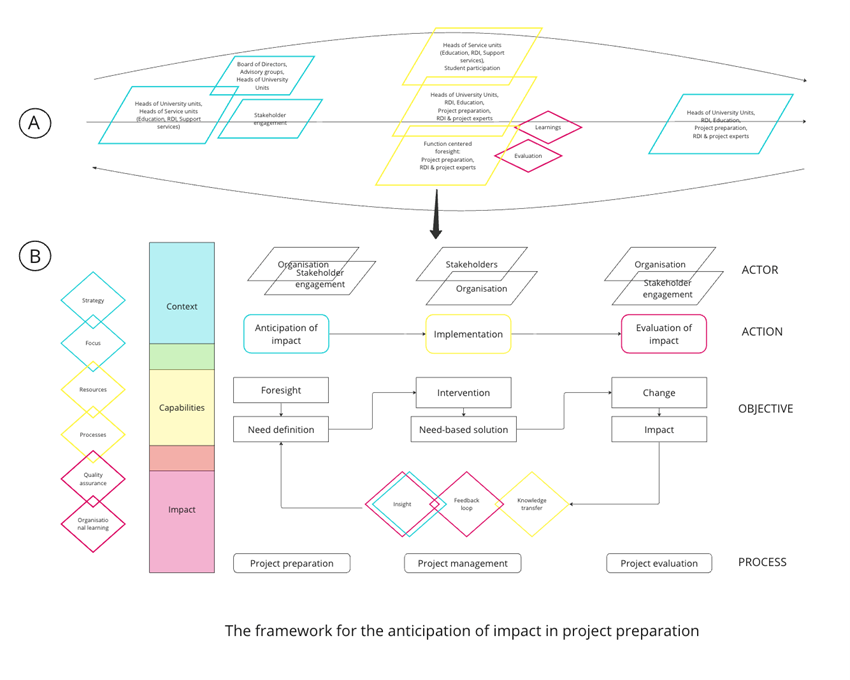Project-based, goal-oriented activity is becoming an increasingly common way to organise work and development in organisations. Projects aim to produce joint solutions for future needs. However, alongside immediate results, the impact of projects, or their longer-term social added value, has gained increasing importance in measuring the outcome of the project. Therefore, this article focuses on presenting a new framework for the anticipation of impact in project preparation.
 Photo by Drew Beamer on Unsplash
Photo by Drew Beamer on Unsplash
Although the importance of long-term impact created through projects has been gaining a foothold as a source of added value, the monitoring of the impact creation lacks systematics. More so, there is often a lack of methodical processes to create feedback loops from the impact evaluations of these projects. To overcome these gaps, a master’s thesis by Helmi-Kanerva Tuori studied the application of foresight in project preparation to enhance long-term impact generation in projects.
According to the findings, the appliance of future thinking and systematic use of foresight on both the organisational level and in the project preparation can lead to better-scoped project implementations, and future-fitting outcomes and hence enhance the creation of a long-term impact in projects.
Through an anonymous survey of a Finnish innovation company’s personnel and interviews conducted with Laurea’s RDI and project experts, success factors for projects were identified, such as early stakeholder engagement in need definition, the value of solid documentation throughout project preparation and implementation, and the importance of a feedback loop for organisational learning and re-targeting activities.
Besides success factors, the following challenges that might hinder the implementation of anticipation in project preparation were discovered:
- a lack of strategic direction,
- a lack of shared understanding of the impact,
- limited time for careful project preparation and in-depth consideration of the impact,
- competition for the same funding instrument within the organisation (where funding is applied from the same source, at the same call, with similar content, by different people),
- having different preparation and implementation teams,
- unmatched expertise among individuals,
- focus on quantitative production over qualitative evaluation and implementation.
Inspired by René Rohrbeck’s (2010) Maturity Model of Corporate Foresight, Tuori applied the context, capabilities, and impact axles (see Figure 1) to address the cyclical differences between organisational level foresight and project-related foresight (organisation), the need for regularity and systematicity in effective foresight activities (systematicity) and continuous resourcing of effective implementation of anticipation (resourcing).
 Figure 1. The framework for the anticipation of impact in project preparation Source: Tuori (2023, p. 47)
Figure 1. The framework for the anticipation of impact in project preparation Source: Tuori (2023, p. 47)
This process model for impact anticipation in project preparation is outlined based on the interview data from the study. It supports effective project implementation by bringing potential need horizons to the center of preparation through foresight. Better motivation of needs and participatory definition of impact goals during project preparation help refine planned project measures. Formulating impact objectives into project measures supports the creation of an impact evaluation criterion and aids in validating impact. Systematic impact assessment provides information on the success of targeting actions and the general success of foresight within the project framework.
This model can be used in all organisations that prepare and implement projects. Due to the future-oriented mindset and diversity of foresight methods, the author believes it is suitable for all industries and actors who develop and innovate purposefully.
To summarize, this article is based on Helmi-Kanerva Tuori’s thesis study on “The anticipation of long-term impact in innovation project preparation”. The thesis is part of Laurea’s master’s degree programme in Leading Transformational Change and presents best practices and pain points of impact anticipation in project preparation while presenting a process model to enhance the appliance of long-term impact anticipation in (innovation) project preparation. The thesis has a practical, project management orientation, and focuses on the transferability of results to different organizations that focus on project preparation and implementation activities, with the aim of creating long-term impact. The topic is related to the expertise of Helmi-Kanerva’s thesis supervisor, Dr. Nikolina Koporcic, who recently got funding from the Research Council of Finland/Academy of Finland (Interactive Network Branding: Increasing the resilience of small businesses in times of crisis – Laurea University of Applied Sciences), as well as from the Interreg Europe/Central Baltic (Central Baltic Mentoring for Migrant Women seeking Employment – Laurea-ammattikorkeakoulu).
About the authors:
Helmi-Kanerva Tuori, Master of Arts (University of Helsinki) finished her Master of Business Administration degree in the Leading Transformational Change program at Laurea University of Applied Sciences with the thesis study “The anticipation of long-term impact in innovation project preparation”, in December 2023, under the supervision of Dr. Nikolina Koporcic. Tuori finds impact-related development both inspiring and essential and hopes to be able to engage with the topic in her future working life and related research efforts.
Dr. Nikolina Koporcic (Ph.D. in Economics and Business Administration) is a Principal Researcher at Laurea University of Applied Sciences and an Academy Research Fellow at the Academy of Finland. Nikolina also holds the title of a Docent (Adjunct Professor) at the University of Turku and acts as an Associate Editor of Business Ethics, the Environment & Responsibility Journal. Her research areas include the co-creation of value, open innovation, corporate branding, entrepreneurship, business relationships and networks. In particular, she is studying the importance of Interactive Network Branding for small firms in business markets. Nikolina has published 17 peer-reviewed academic articles, 3 books, 8 book chapters, 22 conference proceedings, and 11 Laurea Journal articles. orcid.org/0000-0001-5050-3819
Reference list:
- Rohrbeck, R. 2010. Corporate foresight: Towards a maturity model for the future orientation of a firm. Berlin: Physica-Verlag.
Web links: